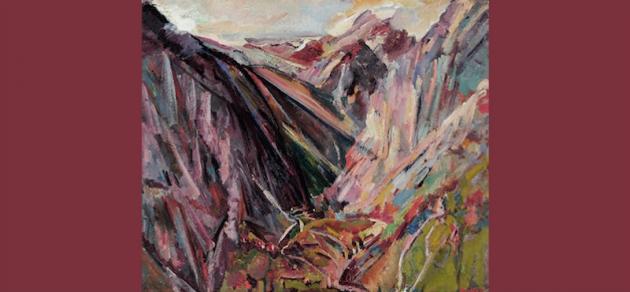A new exhibition of landscapes by the seminal British Modern artist David Bomberg entitled A Sense of Place, has opened at Eastbourne’s Towner Gallery. This major exhibition includes nearly forty paintings made throughout the career of an artist now recognised as one of the most exceptional and original of his generation.
David Bomberg (1890-1957) was the son of Polish-Jewish immigrants, who moved to the East End of London when he was five. After a brief period training as a lithographer, Bomberg studied at the Westminster School of Art under Walter Sickert and later at the Slade School of Fine Art. He was a pioneer of early modernism who created a striking body of expressionistic landscape paintings and drawings following his experiences during World War I. He was disregarded by the British art establishment until after his death in 1957 when his work dramatically increased in value. It took another three decades before he achieved widespread recognition when Tate Gallery mounted a major retrospective in 1988.
David Bomberg: A Sense of Place brings together significant works from the artist’s almost forty-year period of painting and drawing in landscape. From the 1920s to the late 1950s, Bomberg spent extensive periods of time abroad, notably in Toledo, Ronda and Asturias in Spain, Cyprus and Palestine as Cornwall and London.
From 1923 to1927, Bomberg worked in Palestine as the official painter for the Zionist Organisation, documenting the settlement of Jewish immigrants in Jerusalem. In an attempt to satisfy his commission, and disenchanted with the ‘machine age’ as a result of his experiences during World War I, he combined the modernist geometric style of his pre-war work with the figurative observation of the English landscape school, in works such as Jerusalem, Looking to Mount Scopus, 1925; The Broken Aqueduct; Wadi Kelt, near Jericho, 1926 and The South East Corner, Jerusalem, 1926. Throughout the 1930s Bomberg’s art became broader and more impassioned as he sought to convey the essence of his impressions of landscapes in Spain and elsewhere in works such as Valley of La Hermida, Asturias, Spain, 1935 and Ronda Bridge, 1935, although this work met with little approval in Britain.
During World War II Bomberg produced an outstanding series of Bomb Store paintings and charcoal drawings of the blitz-ravaged City of London as seen from a tower near St. Paul’s Cathedral. One of these studies was eventually worked into the dramatic oil painting Evening in the City of London, 1944. Although these works did not lead to further commissions from the War Artists Committee, some now reside in the collections of IWM London and Tate.
Despite being overlooked as an artist during much of his lifetime, Bomberg was a well-regarded teacher and in 1947 formed the Borough Group with his students. His last years were overshadowed by the realisation that his art had low recognition and was even belittled in Britain. His final landscapes and figure works are amongst his most powerful, including a charcoal on paper work, The Bridge at Ronda, 1954 and his last painting, Tajo and Rocks, Ronda (The Last Landscape), 1956-57.
DAVID BOMBERG A SENSE OF PLACE, TOWNER GALLERY EASTBOURNE 9 JUL – 11 SEP 2016 FREE ENTRY

